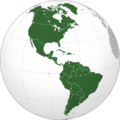Social:Formative stage
Several chronologies in the archaeology of the Americas include a Formative Period or Formative stage etc. It is often sub-divided, for example into "Early", "Middle" and "Late" stages.
The Formative is the third of five stages defined by Gordon Willey and Philip Phillips in their 1958 book Method and Theory in American Archaeology.[1] Cultures of the Formative Stage are supposed to possess the technologies of pottery, weaving, and developed food production; normally they are very largely reliant on agriculture. Social organization is supposed to involve permanent towns and villages, as well as the first ceremonial centers. Ideologically, an early priestly class or theocracy is often present or in development.[2]
Sometimes also referred to as the "Pre-Classic stage", it followed the Archaic stage and was superseded by the Classic stage.[3]
- The Lithic stage
- The Archaic stage
- The Formative stage
- The Classic stage
- The Post-Classic stage
The dates, and the characteristics of the period called "Formative" vary considerably between different parts of the Americas. The typical broad use of the terms is as follows below.
North America
In the classification of North American chronology, the Formative Stage or "Neo-Indian period" is an term applied to theoretical North American cultures that existed between 1000 BC and 500 AD. There are alternative classification systems, and this ranking would overlap what others classify as the Woodland period cultures.
The Formative, Classic and post-Classic stages are sometimes incorporated together as the Post-archaic period, which runs from 1000 BC to the present. Sites & cultures include: Adena, Old Copper, Oasisamerica, Woodland, Fort Ancient, Hopewell tradition and Mississippian cultures.
Meso-America
In Mesoamerican chronology the Preclassic or Formative runs from about 2000 BC to 250 AD, covering all the Olmec culture and the early stages of the Maya culture.
South America
In the periodization of pre-Columbian Peru the Formative Period divides into 1) the Initial Period, from 1800 BC – 900 BC (sites & cultures: Early Chiripa, Kotosh culture, Cupisnique, Las Haldas, Sechin Alto), and 2) the Early Horizon or Formative Period, 900 BC – 200 BC, (Chavín, Late Chiripa, Paracas, Chankillo).
See also
- Category:Archaeology of the Americas
- Mound Builders
- Southeastern Ceremonial Complex
References
- ↑ Willey, Gordon R. (1989). "Gordon Willey". in Glyn Edmund Daniel and Christopher Chippindale. The Pastmasters: Eleven Modern Pioneers of Archaeology: V. Gordon Childe, Stuart Piggott, Charles Phillips, Christopher Hawkes, Seton Lloyd, Robert J. Braidwood, Gordon R. Willey, C.J. Becker, Sigfried J. De Laet, J. Desmond Clark, D.J. Mulvaney. New York: Thames & Hudson. ISBN 0-500-05051-1. OCLC 19750309.
- ↑ Gordon R. Willey and Philip Phillips (1957). Method and Theory in American Archaeology. University of Chicago Press. ISBN:978-0-226-89888-9.
- ↑ "Method and Theory in American Archaeology" (Digitised online by Questia Media). Gordon Willey and Philip Phillips. University of Chicago. 1958. https://www.questia.com/PM.qst?a=o&d=6136197. Retrieved 2009-11-20.
Template:Indigenous peoples of the Pacific Northwest
 |



